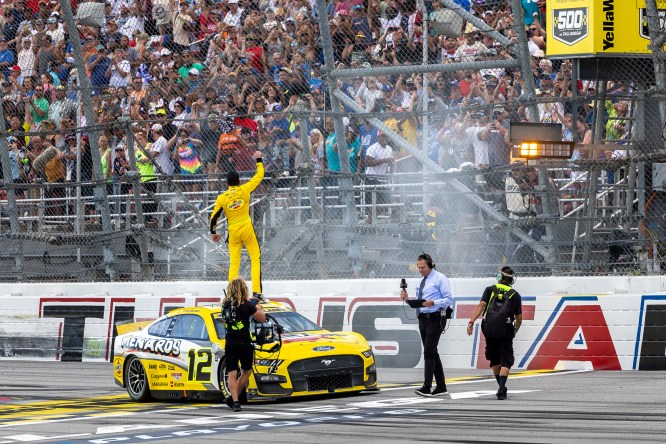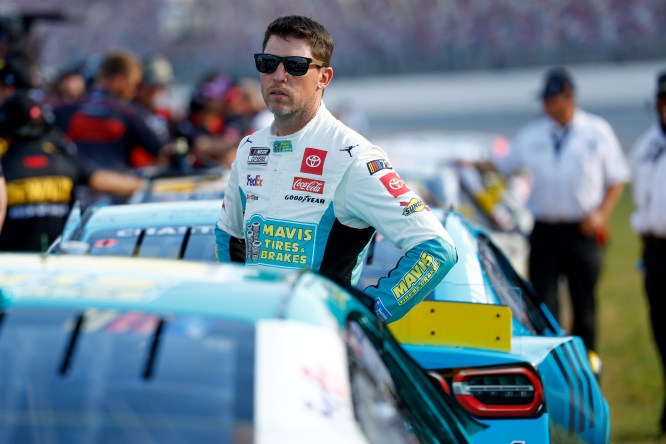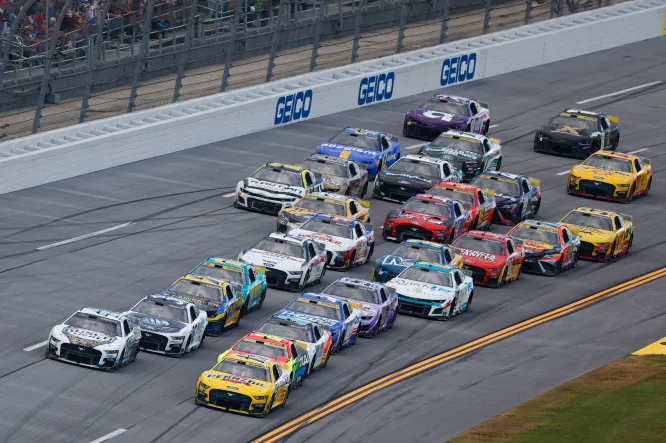Ryan Blaney was kind of the afterthought.
He is inherently not particularly flashy by nature but is especially under the radar during a season in teammate Joey Logano, the two-time and defending champion, has already been eliminated from the Cup Series playoffs and Team Penske has largely struggled.
He keeps getting written off from round to round, and after winning at Talladega Superspeedway on Sunday, the No. 12 team keeps advancing — external expectations be damned.
“Yeah, I mean, I definitely think it’s probably not been the year we wanted at our group, right,” Blaney said. “You go from winning the championship with (Logano and) the 22 guys and then we’ve struggled a little bit this year overall for speed and finishes and stuff like that.
“Joey getting knocked out in the first round was definitely a gut punch. Yeah, it’s easy to get down on that stuff, but it’s easy to get fired up about things too.”
It’s not apples-to-apples but Logano wasn’t exactly a popular championship pick going into the playoffs last season, either. By this point of last season, Logano had just two victories, the same number that Blaney has now, before scoring victories at Las Vegas and Phoenix to win the title.
“I admire those guys a lot,” Blaney said of Joey Logano and crew chief Paul Wolfe. “Joey, I feel like he is always really good at making a lot out of something out of little. I feel like they do that all the time. He and Paul do a great job of that.
“Joey is very smart and mentally strong in those situations to where he is always looking towards the future. And that’s something I’ve kind of look at of how he approaches things because there’s times where, man, they’re not very good, and they’ll go pull something out, and they’re just tough and they figure it out. It’s not a coincidence that that happens to them. They think about this stuff, and they’re very mentally strong when it comes to these things and always trying to be better.”
‘Weird’ stat ties Ryan Blaney to Joey Logano

Blaney has a 13.6 average finish, nearly identical to the 13.5 that Logano took the championship last season but is still far short of the top-5 comparison 5-to-11 with five races left to go.
“Yeah, I didn’t know that stat,” Blaney said. “I don’t know whether to like or dislike that.”
It’s weird, right?
“It is weird,” he agreed. “I feel like (this season has) been up and down. I feel like we were really solid until winning in Charlotte and then I would say up until Sonoma, and then we kind of lost our way a little bit after the break and just struggled to kind of find speed and put together races and making mistakes, whether it’s my mistakes or pit road.
“I feel like we’ve done a good job as the playoffs have started kind of managing these races like we need to and getting back on track.
“But it is kind of weird because I feel like we had a lot more top-5s and contended for more wins last year but didn’t execute very good. This year I feel like we’ve executed pretty good, especially since the two-thirds mark of the season and that’s something to be proud of.”
And now, really, none of the stats matter.
Blaney will go to Las Vegas, Homestead-Miami and Martinsville Speedway with a chance to punch his ticket to the Championship Four, something he has never accomplished to this point of his career. The math, from that standpoint gets pretty easy.
Blaney says he just can’t make mistakes.
“Last year I made two massive mistakes and kept us out of Phoenix,” he said. “So I think learning from prior experiences is beneficial there. Obviously you need your cars to be fast enough because it gets super tough, and these racetracks are super hard.
“When everything resets, you have guys that have tons of points. Today helped us out a little bit, but a couple guys have way more playoff points than us. That makes it super tough. But if we can learn from our past mistakes and have fast cars, and not mess up really … this could be a big shot in the arm.”
Related: How the modern NASCAR playoff system has forever changed the game
Updated playoff grid
William Byron Advanced
Ryan Blaney Advanced
Denny Hamlin +50
Christopher Bell +22
Chris Buescher +19
Martin Truex Jr. +17
Kyle Larson +15
Brad Keselowski +2
—
Tyler Reddick -2
Ross Chastain -9
Bubba Wallace -9
Kyle Busch -26
Stage points are everything
A couple of takeaways here: First, Brad Keselowski is a perfect case study about why stage points are so valuable during the NASCAR Cup Series playoffs as the 10 he scored, by virtue of winning the second stage, is the difference between starting the final race of this round +2 or -12.
Kyle Larson benefited from his aggression at the one-thirds and halfway portions of the race, scoring 12 stage points before being crashed out of the top-five just feet prior to taking the checkered flag where he was scored 16th. That’s a 11-point swing and his stage points are the difference between going into the ROVAL +15 or +3.
Conversely, Bubba Wallace got no stage points and finished 24th and that’s why he’s got ground to make up on his worst type of track, road courses.
“Yeah, and we were buried from Lap 4 and it’s so hard to get back up there,” Wallace said. “Anytime you get a run up top, someone would pull up and we would be like the sixth car in lane and just got blocked out. That was our day. We didn’t manage our track position from the start. Once we lost it, that was hard.”
The current championship format continues to be hotly debated between the purists and modernists but there is no denying that the status quo both encourages and rewards performance throughout the race is paying points to the top-10 finishers at the end of each stage break.
It will absolutely determine who advances to the Round of 8 by the end of the ROVAL race next Sunday, too.
The likes of Wallace, Tyler Reddick, Chris Buescher and Martin Truex Jr. not scoring playoff points actually further mitigated the damage to Keselowski and Chastain. Sure, Keselowski scored 10 stage points and that was to his benefit but those on the bubble scoring none also prevented Chastain from falling back any further in the standings.
Nine points is very doable next week.
In fact, the only driver facing must-win odds at the ROVAL is Busch, who has dealt with both a lack of performance and bad luck, the latter which was on display when he was caught up in the crash with Chastain and Ricky Stenhouse Jr. — triggered by the latter running out fuel.
“The car actually drove fine after that,” Busch said. “I moved up at the end and had a couple of guys go with me, like the 43, and we didn’t go anywhere. The pace was too fast around the bottom and the middle that the outside couldn’t make any headway.
“I was waiting for the 11 to jump outside and he never did.”
Hamlin, more on him later, but he didn’t want to sabotage the points day he had established.
“I got asked why I didn’t pull up to win the race,” Hamlin said. “Well, because I just saw all the playoff cars we passed on the bottom and if I go to the top, I have a chance to win but I also have a chance to run 20th. That’s 15 points.”
Busch now needs to make up 26 points, and more than likely, that means winning the race.
“It’s our last shot, so we’ll see what we can get.”
Related: Joey Logano wants radical NASCAR rules change every year or two
Denny delivers comeback

Denny Hamlin was not as desperate or as at-risk as some of his peers in the playoffs, having entered with a +37 point advantage to the cutline but he could have undone it with a mistake and misfortune.
He screwed up, and he’ll be the first to admit it, when he caught speeding on Lap 105.
“Just pushing it,” Hamlin said. “My mindset is ‘I’m leading the pack and don’t get run into.’ I didn’t want to be too conservative and have the entire pack run into me but I just fucked up like I do every year like I do in the playoffs.
“It’s just dumb and it’s the one time you can’t do that and I managed to.”
But he also managed to battle his way back. He never wavered in racing with the leaders, even whilst a lap down, just barely losing the free pass to Carson Hocevar at the stage two break. He would catch a debris caution with 22 laps to go to get back on the lead lap and raced all the way back to fourth.
“You’re just waiting every lap for something to happen or a piece of debris somewhere on the racetrack to get a caution, … so it’s nerve-racking because it forced me to have to race more aggressive earlier than I wanted to,” Hamlin said.
He will enter the ROVAL 50 points above the cutline, as close as you can get to being locked in, without being actually locked in. A maximum of 60 points can be earned during a race.
“I couldn’t ask for much more,” Hamlin said. “I was hoping to hold serve. The last 25 laps were really good for us.”
Wildest NextGen pack race yet

How about this for a stat:
There were 70 lead changes on Sunday, the most in a Cup Series race at Talladega since the fall of 2011, when there were 72. Beyond the hard numbers, the drivers frequently raced three-wide all afternoon, something they said last year was more challenging with this platform.
So what does Denny Hamlin think changed this fall?
“I certainly thought the racing today was better than what we’ve had with the NextGen on superspeedways,” Hamlin said. “I think we are just getting smarter with it and understanding how many cars it takes to make a line go and that’s the result we saw.”
Is that fun?
“It’s fun to me and I think this is when a driver’s skillset is more apparent,” said the three-time Daytona 500 winner.
Ryan Blaney thinks the fuel strategy element factored into how everyone raced on Sunday.
When Ricky Stenhouse Jr. ran out of gas at the end of the first stage, triggering the crash with Kyle Busch and Ross Chastain, that was an insight into how much fuel the leading driver burns compared to those deeper in the pack.
So with no one wanting to spend an entire run up front, they traded the lead a lot and frequently ran three-wide off the throttle in an effort to save fuel.
Ryan Blaney said that’s entirely when the third lane manifested itself.
“It’s honestly just a massive fuel mileage race now,” Blaney said. “Where the stages are, how — you know, the less time you can spend on pit road the better, and you gain your track position.
“Literally the first stint of each stage everyone is just saving gas. I mean, I ran 50 percent throttle damn near the whole first stint of each stage just to save gas so I’m on pit road the less amount of time, take less gas, you jump the cars that are using more gas.
“When the leaders of the bottom lane, the middle lane, start doing that, the through lane develops because you have guys that are, like, screw it, I’m not going to save. I’m trying to get to the front.”
Blaney said the lanes sped up or slowed down based on how much throttle drivers were using.
“It’s a weird thing as a driver because we got back I think in the second stage and I was almost at the very back of the pack, but I just saved a ton of gas on the bottom, and I came out, like, third in our group because I had to take less gas, and that propelled us towards the front,” he said.
“So it’s a weird kind of game. It’s different than what it has been, but everyone is kind of catching on to the saving fuel type situation. That’s really what brings the third lane up there a lot. At the end of the race when everyone is not saving gas and you are pushing hard in the first lane and second lane, the third lane doesn’t really go anywhere. It’s kind of a funky deal but a lot of passes and I hope people enjoyed it.”
Matt Weaver is a Motorsports Insider for Sportsnaut. Follow him on Twitter.